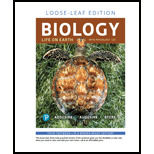
Pearson eText Biology: Life on Earth with Physiology -- Instant Access (Pearson+)
12th Edition
ISBN: 9780135755785
Author: Gerald Audesirk, Teresa Audesirk
Publisher: PEARSON+
expand_more
expand_more
format_list_bulleted
Concept explainers
Question
Chapter 3, Problem 4RQ
Summary Introduction
To describe:
The similarities and differences between fats and oils and the way through which the differences are responsible for explaining the solid and liquid state at room temperature.
Introduction:
Lipids are the biological molecules which are comprised entirely of carbon, oxygen, and hydrogen. They contain nonpolar carbon-hydrogen and carbon-carbon bonds. These regions of lipids are hydrophobic and this facilitates the insolubility in water.
Expert Solution & Answer
Want to see the full answer?
Check out a sample textbook solution
Students have asked these similar questions
What does bile salts do to fats in the body?
What are the chemical and physical differences between fats and oils?
How are saturated and unsaturated fat different ?
Chapter 3 Solutions
Pearson eText Biology: Life on Earth with Physiology -- Instant Access (Pearson+)
Ch. 3.1 - which of these is/are polar molecules? (you may...Ch. 3.1 - define organic molecules and explain why carbon is...Ch. 3.1 - explain why functional groups are important in...Ch. 3.1 - name and describe the properties of seven...Ch. 3.2 - define organic molecules and explain why carbon is...Ch. 3.3 - Describe hydrolysis of this molecule.Ch. 3.3 - describe the major types of carbohydrates?Ch. 3.3 - provide examples of each type of carbohydrate and...Ch. 3.4 - Look up the rest of the amino acids and. based on...Ch. 3.4 - Infectious prions such as those that cause mad cow...
Ch. 3.4 - Why do many proteins, when heated excessively....Ch. 3.4 - Why a Perm Is (Temporarily) Permanent?Ch. 3.4 - describe protein subunits and how proteins are...Ch. 3.4 - explain the four levels of protein structure and...Ch. 3.4 - list several functions of proteins and provide...Ch. 3.4 - Prob. 4CYLCh. 3.5 - describe the general structure of nucleotides?Ch. 3.5 - list three different functions of nucleotides?Ch. 3.5 - explain how nucleic acids are synthesized?Ch. 3.5 - give two examples of nucleic acids and their...Ch. 3.5 - Puzzling Proteins All cells use DNA as a blueprint...Ch. 3.6 - What kind of reaction breaks this molecule apart?Ch. 3.6 - An obese 55-year-old woman consults her physician...Ch. 3.6 - Why are steroid hormones able to diffuse through...Ch. 3.6 - compare and contrast the structure and synthesis...Ch. 3.6 - describe the functions of fats, oils, and waxes?Ch. 3.6 - Prob. 3CYLCh. 3.6 - Prob. 1CTCh. 3 - Polar molecules a. dissolve in lipids. b. are...Ch. 3 - Prob. 2MCCh. 3 - Prob. 3MCCh. 3 - Which of the following is not composed of...Ch. 3 - Prob. 5MCCh. 3 - In organic molecules made of chains of subunits,...Ch. 3 - Prob. 2FIBCh. 3 - Prob. 3FIBCh. 3 - Prob. 4FIBCh. 3 - Fill in the following with the appropriate type of...Ch. 3 - Prob. 1RQCh. 3 - List the four principal classes of biological...Ch. 3 - Prob. 3RQCh. 3 - Prob. 4RQCh. 3 - Prob. 5RQCh. 3 - Describe the synthesis of a protein from amino...Ch. 3 - Where in nature do we find cellulose? Where do we...Ch. 3 - Based on their structure, sketch and explain how...Ch. 3 - Prob. 2ACCh. 3 - Prob. 3AC
Knowledge Booster
Learn more about
Need a deep-dive on the concept behind this application? Look no further. Learn more about this topic, biology and related others by exploring similar questions and additional content below.Similar questions
- Draw an example of each of the following lipids, and compare and contrast them: Triacylglyceride, Glycerophopholipids, Sphingolipids - How are the components similar? How are they different? Draw an example of each of the following lipids, and compare and contrast them: Bile Acids, Steroid Hormones - How are the components similar? How are they different?arrow_forwardWhat are two examples of structural lipids and two examples of storage lipids?arrow_forwardMost animal fats are solid at room temperature, whereas plant and fish oils tend to be liquid. Both contain fatty acids. Can you predict which type of fat contains saturated fatty acids, and which type contains unsaturated fatty acids?arrow_forward
- Do you think that glycerol can be found in all fats? Why? What are Sphingolipids? What is the nature of the emulsion? How does it differ from those of a mixture of coconut oil and water and coconut oil and egg white? Is energy always associated with biochemical processes? How?arrow_forwardWhich of the following is true of unsaturated fats?(A) They are more common in animals than in plants.(B) They have double bonds in their fatty acid chains.(C) They generally solidify at room temperature.(D) They contain more hydrogen than do saturated fats havingthe same number of carbon atomsarrow_forwardHow do fats function?arrow_forward
arrow_back_ios
SEE MORE QUESTIONS
arrow_forward_ios
Recommended textbooks for you
 Human Biology (MindTap Course List)BiologyISBN:9781305112100Author:Cecie Starr, Beverly McMillanPublisher:Cengage Learning
Human Biology (MindTap Course List)BiologyISBN:9781305112100Author:Cecie Starr, Beverly McMillanPublisher:Cengage Learning Biology: The Dynamic Science (MindTap Course List)BiologyISBN:9781305389892Author:Peter J. Russell, Paul E. Hertz, Beverly McMillanPublisher:Cengage Learning
Biology: The Dynamic Science (MindTap Course List)BiologyISBN:9781305389892Author:Peter J. Russell, Paul E. Hertz, Beverly McMillanPublisher:Cengage Learning

Human Biology (MindTap Course List)
Biology
ISBN:9781305112100
Author:Cecie Starr, Beverly McMillan
Publisher:Cengage Learning

Biology: The Dynamic Science (MindTap Course List)
Biology
ISBN:9781305389892
Author:Peter J. Russell, Paul E. Hertz, Beverly McMillan
Publisher:Cengage Learning
Nutrition and Diet - GCSE Biology (9-1); Author: Mr Exham Biology;https://www.youtube.com/watch?v=SFE1DfAlipo;License: Standard Youtube License